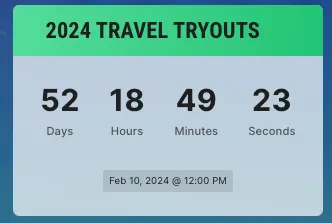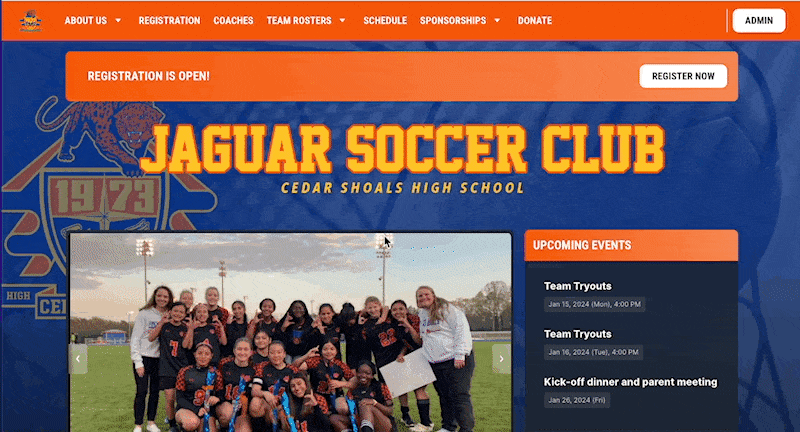
Table of Contents
Whether you run a recreational soccer league or a competitive club, you must manage a website year-round to build and grow your organization.
A well-organized website can help your soccer organization find new players, manage registration, communicate with parents, collect more donations, and more!
Follow our step-by-step guide below to build an awesome youth soccer website before your next season.
How to make a soccer website
1. Get a sports website builder
The first step in building a soccer website is to choose a platform. There are dozens of different website builders to choose from. If you're a volunteer, you should prioritize finding a website builder that is simple to use so you're not investing a lot of your time managing the website.
In most cases, you should use a website builder with key features just for sports teams. Sports website builders can save time and money because they have built-in templates for website content, registration, donations, scheduling, and other functionalities.
🧠 Learn more: The Best Youth Sports Management Apps
2. Plan your website content
Every sports team website needs content so visitors can find everything without contacting your volunteers or board. There are a few things you should get together when starting to build your website:
- A high-resolution version of your logo
- Some action photos or video replays from a previous season
- Codes of conduct and any other essential documents for players or parents
- Board member and coaching staff contact information
- Current sponsors and sponsorship package information
- Social media profiles
You should plan to update content regularly (at least once per month throughout the year). However, getting basic information together before you start building your website can help speed up the process so you can launch your new website quickly.
🧠 Need more content ideas? Learn how to create a youth sports website.
3. Customize your homepage
Your website should showcase all of the important events throughout the year. You can categorize the events by team, fundraisers, and organization-wide events.
Here are a few sections you should definitely add to your homepage:
Upcoming events
Your website should showcase all of the important events that take place throughout the year. You can categorize the events by team, fundraisers, and organization-wide events. Here are a few event types to include:
- Game or tournament schedules
- Tryouts, camps, and any other offseason events
- Board meetings and other administrative events
Announcements
Important announcements like schedule updates, cancellations, and fundraising progress should all be on your organization’s homepage.
Donations
Your soccer program's website should serve as a year-round fundraising tool for your organization. On your homepage, make it easy for your website visitors to donate.
Including a detailed description of how donation dollars are used and how the donation will impact players is critical! Make sure your website visitors know why contributions are essential, regardless of the amount.
Image slideshow with clickable links
You should update images on your website often. A slideshow on the homepage is a great place to include high-quality action photos from games and other events.
You can also link your images to high-priority pages on your website. For example, when online registration opens, you can link the first image to your registration page. Another great idea is to include your largest sponsor in your slideshow to encourage sponsors to make donations to your organization.
Countdowns
Add a countdown to an upcoming event to create momentum and excitement for website visitors.

Here are a few more ideas to take your homepage to the next level:
- Embed a YouTube video.
- Recognize sponsors in a slider.
- Feature your social media accounts.
- Include maps to locations if you have travel teams.
- Add photo albums with photos of each team or season.
- Create a customized contact form so visitors can reach out to your board.
4. Add your website pages
Website pages can include team rosters, game schedules, tryout information, your mission statement, and anything else necessary for your sports club or league. You can organize your pages in a navigation with both dropdown menus and links to external websites.

Aim to have at least ten pages on your website when you launch the site. Include ways for people to get involved, either by volunteering or becoming a youth soccer sponsor. If you make it easier for new people to help your organization, you might be surprised at how many new volunteers you get.
5. Register a domain
Your soccer website needs a domain. A domain is just the website address or URL for your homepage.
Get a domain that is easy for people to remember and try to include the name of your team or league. You want the domain to be as short as possible while long enough to be informative with the name or abbreviation of your soccer program. The optimal domain name length for a sports organization is between 10 and 20 characters.
Many website builders like Jersey Watch include a domain name in the pricing plans, so you don’t have to worry about buying a domain separately. Or, if you prefer to buy a domain name, use a service like GoDaddy or Namecheap. The good news about domains is that you can transfer them between web hosts. So, if you’re making a new website, you can use the same domain that your organization has used in the past.
6. Launch your new soccer website
Many website builders will allow you to create a free website before publishing and activating your domain. Once you've built your content, you can publish and launch your website.
After your site is published, immediately post it on social media. If you have an email or text list, send a notification to your contacts to let them know you have a new website!
🧠 Starting a new league? Learn more: How to Create a Youth Soccer League
7. Optimize your club website for SEO
When your soccer club's website goes live, make sure it's easily discoverable online. SEO involves implementing a bunch of techniques to make your website rank higher in search engines, boosting its visibility to people searching for soccer clubs.
Most sports website themes should take care of the SEO basics for you. Some ways to optimize your website include:
- Use relevant keywords in your text (like the town your organization plays, the seasons you participate, and age groups you support).
- Add new content regularly.
- Get quality backlinks by linking to your website form social media, and other community websites
- Create an FAQ page to answer visitors’ questions.
- Create an About Us page for your club.
You can also improve your online presence by updating your site regularly with engaging content like upcoming matches, player profiles, and event info. You can also get more visitors by using local SEO tactics and integrating social media platforms.
Soccer website design tips
It’s important that your website is easy to navigate and has a modern look. A good sports website design helps build credibility in your community, get people interested in your club, and ultimately register more players.
Here are a few of our top soccer website design tips:
- Use high-resolution images.
- Get your colors to match your logo exactly (with hex codes).
- Include a countdown to an upcoming event, even in the offseason.
- Add a donation section on your homepage.
Best soccer website examples
Some of the best soccer website examples can help inspire your club or league. Here are a few of our favorite soccer websites.
Sitka Rush Soccer Club

The Sitka Rush Soccer Club website provides all the information parents, sponsors, and community members need about the organization.
The website has a clean navigation with easy access to registration information, event countdowns, and important documents . Parents can also access practice plans and learn how to become a sponsor or donor. You can also quickly locate organization information like meeting dates and board member contacts.
Fentress County Soccer Club

Fentress County Soccer Club is a non-profit recreational soccer organization run by dedicated volunteers. They operate year round.
They keep their website updated with important information about each season and include a Contact Us form on their homepage so parents can quickly get in touch with a board member.
They also make it super easy for parents or sponsors to donate and make payments.
Jaguars Soccer Club

Jaguars Soccer Club supports boys and girls teams at Cedar Shoals High School.
Visitors can easily access JV and Varsity game schedules on the website, and general events like tryout dates and fundraising events are also easy to access.
They also promote each team with social media accounts on the homepage. Plus, make it super easy for donors or sponsors to get involved by paying through the website.
Overall costs for building a soccer website
There are a few to consider when building a website for your soccer team or organization. The main costs are website builder, hosting, and a domain name. However, most sports website builders will include everything in one package to make it easy.
Overall, costs to build and maintain the website should be less than $1,000 per year. In most cases with smaller organizations, a few hundred dollars per year should be plenty to keep the website. The costs can increase significantly if you decide to pay a website developer to maintain a website. Still, many user-friendly website builders are available that make it easy for anyone with an internet connection to set up a website.
If you want to collect online payments for registration, donations, and sponsorships, consider credit card processing fees, which can be between 3-6% per transaction.
Use Jersey Watch’s soccer website template to build your site
Jersey Watch is built for youth and community sports organizations. Use our soccer website builder to set up a website in just a few minutes for your soccer program. There are built-in features to manage soccer registration forms, collect payments, send messages, and more!